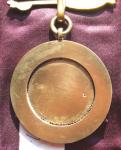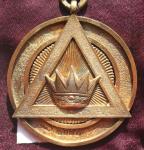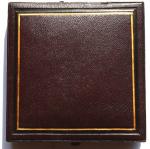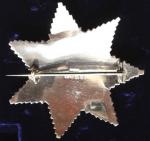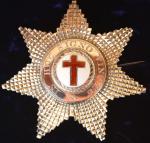-
Posts
13,225 -
Joined
-
Last visited
-
Days Won
22
Content Type
Profiles
Forums
Blogs
Gallery
Events
Store
Everything posted by Mervyn Mitton
-
-
-
-
-
-
-
-
-
-
-
-
These three early pieces of Masonic Regalia have just come-in - two of them are silver gilt and the Breast Star is silver. All are hallmarked and are in their original boxes - two of which have the name of the London maker. One in particular , has the name SOMERSETSHIRE around the body - so, obviously a link to that County. The Star is 5 1/2 inches across (6.5 cm) Marks are for BIRMINGHAM 1853. I am hoping that some of our members will recognise the ranks that held them and also, give any other information that may be available.
-
Having been talking with Monty on this East End of London area (Whistles) - I thought I would ask two general questions - a little test of geography. 1. Danny La Rue sang a hit song in the 1960/70's - ' On Mother Kelly's Doorstep' Where was this building and what was Mother Kelly ? 2. The famous comedy pair - Flanagan and Allen - sang a very famous song in the 1930/40's - ' Underneath the Arches' What and where were the Arches ? May be a little dificult for our overseas members - should be a 'breeze' for Craig ? Have a go - no google though.
-
I had a feeling it might be Sidney Street - but it looked like the Section House - if you know what I mean............. It is 42 years since I've been near the place. I don't remember Sidney Street looking as clear as this - it became part of (Watney's ?) the brewery. It was burnt out - perhaps the brewery has gone and they have restored the original terrace? No, I still remeber the area - my flat was in Gore Road - part of the Crown Estate (my lease named it between me and the Queen) I gave it up about 12 years ago - however, I had no need to go near the Highway. I used it for overnights when I came-up from Bournemouth on business or, shopping. Whilst there is great historical interest in the area , the fact is that it has changed a lot - they used to send pamphlets from Hackney Council in 11 official languages. Most of the early residents are now in Essex or, Golder's Green ! I won't watch East Enders for the same reason - I'm sure I've arrested most of the older ones - and the rest should be ! Incidentally, the section house you show is not 'mine' - that was just off the Highway. Mervyn
-
A nice pistol Ed. Bear in mind that they would usually have had a pair - so, that gave four shots. Pity it has lost the nipples - but these can easily be replaced by a good gunsmith. Are there any naming details ?
-
Hi - Monty. That is the old Section House isn't it ? So long since I've been anywhere near. I used to park my TR5 where the photo was taken from and my window was 1st. floor - fourth from left - I lived there from Jan.1968 for 18 months and then had special permission from CO (Scotland Yard) to share a flat with another PC from my Station. There were other Sect.Houses - I know there was one for the Isle of Dogs - but they were gone by the time I was posted. The main road at that point is the Ratcliffe Highway - runs from Tower Hill to Wapping. Thames River Police were established off of it - and it formed part of the Shadwell Magistracy - my illustration on my detail section on each post, is for the Shadwell Magistrate in 1800. When criminals - or, suicides - had to be buried in those pre-1820 days, they could not be buried in Consecrated ground and were buried in the centre of cross roads. The Ratcliffe Highway is notorious for the number of bodies buried along it's length and they are often turned-up in road workings. The Siege of Sidney Street is a very famous event - mainly because of the three City policemen killed and also because Winston Churchill - as Home Secretary, brought a detachment of Guards and took part in the firing against the building. Without checking, I think it took place in 1910 - the year my Father was born. Now that we have mentioned this event it would be nice to have a short article for our members. Should it not interfere with your professional aspect it would be good if you could do this ? My Home Beat was along Cambridge Heath from the Museum and then turned left along Mile End Road, I was responsible for 20,000 residents, but you will appreciate that in my absence it was covered by normal patrols. I think now that this type of policing has gone, which is a pity as it was very effective. I had a lot of the three card trick gangs living in flats and I remember being on a bus in Oxford Street and seeing five of them working a crowd. I made a note and had summonses served on them - they never could believe how I got all five of them. Sidney Street was the other side of the Road and came under Leman Street Police Station. I believe it has been moved now, but was 'H'Divisional HQ. I always thought it funny that a Police Station should be called after the street - Leman Street ! The old French/saxon name for street of prostitutes.... Please keep in touch over your projects - who knows what other details can be dredged out of old memories ?
-
The copper percussion cap had to be kept on the nipple - ready for the hammer to come down. It was normal practise for the hammer to have a halfway position and also right back, ready for firing when the trigger was pulled. The half way position was it's safety - however, drop the weapon and there was a high possibility of it firing. Hence the old expression ' don't go off half cocked' - meaning get your facts right. This was brought into the shop - so I don't know any of it's history. However, I think it is an interesting and beautifully made little piece.
-

8TH HUSSARS
Mervyn Mitton replied to FOR VALOUR's topic in Great Britain: Orders, Gallantry, Campaign Medals
Hi - David. If I remember correctly the 8th Hussars charged at Balaclava. With many other units thay then got sent off to India. Have you checked if he has any other entitlements? -
-
-
-
-
Small flintlock, and later in the 19th. Century, percussion cap, pocket pistols have been with us for a long time. The uncertainties and crime of those early days - and an absence of an adequate police force - ensured that you carried a weapon for self defence. Should you be lucky to have a coach or, a horse - then you could carry heavy pistols, swords and carbines. However, it was dangerous to even walk in the main streets of London and so a small pistol in your pocket might be the saving of your life. Light swords were carried for the same purpose. I showed a little time back, a pair of matched pocket pistols - these had the slab sides to lay flat in the pockets. They were also of quite a large bore. This beautifully made little pistol - only just over 5 inches overall (13cm) - had the same purpose of concealment, but was intended for a lady. How can we tell this with just a quick look - the trigger guard is too small for a man's finger to fit comfortably. Also, the quality and the high decoration give it a feminine appearance. Note the lovely silver filigree inset into the walnut stock - that is workmanship of a high order. The other unusual feature is the brass moulded grotesque mask at the base of the ball grip - this would have been gilt originally. This is not rare -but, is another sign of quality. The unusual thing is that there is no maker's mark - or, indeed any identification. This leads me to think that it may be of Spanish origin - however, the feel is for it to be English. I will be interested to hear what our experts think ? Being made for the protection of a Lady - these bacame known as 'Muff Pistols'. Part of the dress in Georgian and early Victorian times was that a small muff - or, hand warmer - was carried and this concealed the pistol, which would have been in an inner pocket. Handbags developed from these muffs. Altogether , a very nice - and collectable - firearm.
-

PART 11 - POLICE FORCES OF THE WORLD
Mervyn Mitton replied to Mervyn Mitton's topic in Police Forces of the World
Les, I was very sorry to learn that your health is not good. Thankyou for taking the time to add to these World posts - your knowledge is just what is needed to 'flesh' them out and encourage others to add. I have never intended - or, expected - that everything would happen at once. Rather, that over time, they will have added information and become a source of reference - after all, that is what an important Forum, such as GMIC is expected to accomplish. -
Some rare badges amongst this collection, Will. I haven't seen one of the big SAR Helmet Plates for a long time. I agree with you - this was an important Force for South Africa - very interchangeable with the SAP - and it would be nice to have some input from people who served with them - or, remember them ?







